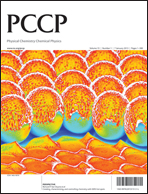A combined high-field EPR and quantum chemical study on a weakly ferromagnetically coupled dinuclear Mn(iii) complex. A complete analysis of the EPR spectrum beyond the strong coupling limit†
Abstract
The electronic and magnetic properties of polynuclear complexes, in particular the magnetic anisotropy (zero field splitting, ZFS), the leading term of the spin Hamiltonian (SH), are commonly analyzed in a global manner and no attempt is usually made to understand the various contributions to the anisotropy at the atomic scale. This is especially true in weakly magnetically coupled systems. The present study addresses this problem and investigates the local SH parameters using a methodology based on experimental measurements and theoretical calculations. This work focuses on the challenging mono μ-oxo bis μ-acetato dinuclear MnIII complex: [Mn2III(μ-O)(μ-OAc)2L2](PF6)2 (with L = trispyrrolidine-1,4,7-triazacyclononane) (1), which is particularly difficult for EPR spectroscopy because of its large magnetic anisotropy and the weak ferromagnetic interaction between the two MnIII ions. High field (up to 12 T) and high frequency (190–345 GHz) EPR experiments have been recorded for 1 between 5 and 50 K. These data have been analyzed by employing a complex Hamiltonian, which encompasses terms describing the local and inter-site interactions. Density functional theory and multireference correlated ab initio calculations have been used to estimate the ZFS of the MnIII ions (DMn = +4.29 cm−1, EMn/DMn = 0.19) and the Euler angles reflecting the relative orientation of the ZFS tensor for each MnIII (α = −52°, β = 28°, γ = 3°). This analysis allowed the accurate determination of the local parameters: DMn = +4.50 cm−1, EMn/DMn = 0.07, α = −35°, β = 23°, γ = 2°. The spin ladder approach has also been applied, but only the parameters of the ground spin state of 1 have been accurately determined (D4 = +1.540 cm−1, E4/D4 = 0.107). This is not sufficient to allow for the determination of the local parameters. The validity and practical performance of both approaches have been discussed.


 Please wait while we load your content...
Please wait while we load your content...